#alkaline water side effects
Explore tagged Tumblr posts
Text
What is Free Radicals and How it Damages Our Body Cells?
Free radicals are harmful molecules. They bear an odd number of electrons in them. The elements try to obtain stability by taking electrons belonging to other molecules. This process leads to oxidative stress. Oxidative stress in general may be a factor that negatively affects different cells and tissues of the human organism. Knowing the sources of free radicals and their impacts on your body will enable you to take preventive measures on the adverse impacts they may have on your health.
Sources of Free Radicals
Free radicals can be internal as well as external since they can derive from the body or the environment. Here are some common sources:
Pollution: Pollutants in the air and toxic materials.
Radiation: Ultraviolet rays and X-rays.
Diet: Sweets and bakery products, and any form of alcohol.
Stress: Emotional and physical stress.
The free radicals produced from these sources affect the human body cells and lead to several illnesses.
How Free Radicals Harm Cells
Free radicals damage healthy cells because they take electrons from cell membranes, proteins, and DNA. This leads to damage and mutation of the cell. However, for many people, the extensive accumulation of this damage eventually results in chronic diseases.
Types of Damage
DNA Damage: It causes mutations which lead to cancer.
Protein Damage: Interferes with insertions and alterations of enzymes and signaling molecules.
Lipid Damage: Damages cell membranes and also induces inflammation.
This damages the immune system and speeds up the aging process from constant attacks from these free radicals.
Protecting Your Cells
Antioxidants counteract the free radicals. Thus they are essential for the body. They donate electrons but do not become restless and hence do not cause any more harm. Here are some ways to boost your antioxidant levels:
Diet: You should take in a variety of fruits, vegetables, and nuts.
Supplements: Start using certain vitamins such as vitamin C, vitamin E, and other forms of antioxidant vitamins.
Hydration: It is recommended to drink alkaline water so that your body can have a shield against oxidative stress.
Alkaline Water Benefits
Alkaline water contains some chemical properties that are different from normal water such as a much higher level of pH. This assists in controlling the acidity in the body hence reducing the effects of free radicals. Alkaline water benefits are as follows:
Hydration: Retained better by cells.
Detoxification: Aids in detoxification.
Energy: Boosts the general health of an individual and his or her physique.
The alkaline water filter price can also be different, but the expenditure can prove to be beneficial in the long run for health issues.
Ionized Water Benefits
Ionized water, another form of alkaline water, offers specific benefits. Ionized water benefits include:
Antioxidant Properties: It assists in the neutralizing of free radicals.
Enhanced Hydration: Enhances hydration of the cell.
Improved Detoxification: Cleans toxins from the human body through natural ways of detoxification.
Therefore if you include the ionized water in your daily diet you will be able to improve your powers to fight oxidative stress.
Conclusion: Free radicals oxidize the molecules contained in our body cells and consequently, they harm the cells tremendously. They result in oxidative stress and they make the body develop chronic diseases. Free radicals are dangerous to cells; therefore antioxidants are critical in their functioning. There is a need to stick to a proper diet, proper supplements, and water intake. Alkaline water benefits are numerous. OSG Alkaline offers the best systems that can improve your hydration level. So, you should buy an OSG alkaline water filter for enhanced health.
#OSG kangen water#kangen ionized water#OSG alkaline water filter price#alkaline water benefits#ionized water benefits#kangen water purifier#alkaline water side effects
1 note
·
View note
Text

Top 8 Health Benefits Of Drinking Alkaline Water at Livlong
Explore the top alkaline water benefits for good health which improves digestion & aids in body detox. Know more about the alkaline water benefits at Livlong.
#what is alkaline water#what is kangen water#benefits of kangen water#health benefits of drinking alkaline water#benefits of drinking alkaline water#alkaline water side effects
0 notes
Text
Benefits of Kangen Water
KANGENSHOP.IN explains you the benefits of Kangen Water. (Electrolyzed Reduced Water)
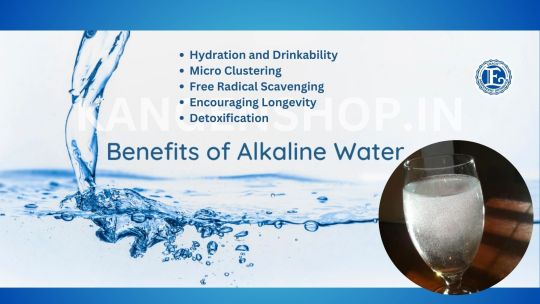
Kangen Water Shop in India
Hydration and Drinkability
Ionized alkaline water® is an excellent source of healthful hydration because not only does it taste better with a superior mouth-feel, it is more readily absorbed by the body. This increases the “drinkability” of water by reducing the usual feeling of being “bloated” from drinking the recommended daily allowance of 8 glasses per day. In side-by-side tests, most people can taste the difference!
Micro Clustering
Preliminary studies have evidenced a phenomenon identified as “micro clustering” which refers to the exceptionally small “structured” molecules of alkaline water. Numerous benefits have been associated with this phenomenon.
Free Radical Scavenging
Ionized alkaline water® supports the wellness of bodily organs while promoting the health of those same organs. Part of the reason for these benefits is that ionized alkaline water has been demonstrated to be an anti-oxidant free radical scavenger.
Encouraging Longevity
Scientifically recognized benefits of water include the support of wellness and longevity. The natural benefits of water are encouraged and enhanced by alkalinity. Alkalinity is the state in which water is most harmonious with its physiological wellness benefits.
Detoxification
Water is the universal solvent that our bodies rely on for flushing toxins and waste products from the body. With its negative oxidation reduction potential (ORP) and great taste, you can count on ionized alkaline water such as Kangen Water® to aid in the neutralization of free radicals and address all of your body’s hydration needs.
#benefits-of-kangen-water#benefit-of-kangen-water#is-alkaline-water-good-for-you#is-kangen-water-good-for-you#kangen-water-side-effects#alkaline-water-is-it-good-for-you#is-alkaline-water-good-for-health#is-kangen-water-good-for-health#kangen-alkaline-water-benefits#kangen-water-benefits-in-hindi#alkaline-water-is-good-for-you#alkaline-ionised-water-benefits#is-alkaline-water-healthy-for-you#kangen-water-advantages#kangen-shops-in-india#kangen-water-shop-in-india#kangen-shop-in-india#kangen-water-shops#kangen-water-shop#kangen-store#kangen-shop#kangen-stores#kangen-stores-india
0 notes
Text
Black Water: The Big Marketing Scam of Alkaline Water
Black water is actually a marketing gimmick that has no scientific backing and may even harm your health. Alkaline water is actually only healthy if it is natural.
Black water is a type of bottled water that claims to have various health benefits due to its high pH and fulvic acid content. However, there is no scientific evidence to support the claims that black water can improve health or prevent diseases. In fact, black water may have some negative effects on health, such as lowering blood pressure, interfering with medication absorption, and causing mineral imbalances. In this essay, we will expose the truth about black water and why it is not as healthy as you think.
What is Black Water and How is it Made?
Black water is a type of artificially alkaline water that is colored with fulvic acid. Fulvic acid is a natural substance that is found in soil and plants, and it is said to have antioxidant, anti-inflammatory, and detoxifying properties. However, the amount of fulvic acid in black water is very low, and it may not have any significant effect on health.
Black water is made by ionizing regular water by passing an electric current through it. This process splits the water molecules into hydrogen ions (H+) and hydroxide ions (OH-), and increases the concentration of OH- ions in the water. This results in a higher pH, but it does not add any minerals or nutrients to the water. In fact, artificial ionized alkaline water may lose some of its beneficial properties over time, as the OH- ions react with carbon dioxide in the air and form bicarbonate ions (HCO3-), which lower the pH.
Why is Black Water Not Beneficial for Health or pH Balance?
One of the main selling points of black water is that it is alkaline, meaning that it has a pH higher than 7. The pH scale measures how acidic or basic a substance is, and it ranges from 0 to 14. The human body has a slightly alkaline pH of around 7.4, and it maintains this level through various mechanisms. Some people believe that drinking alkaline water can help balance the body’s pH and prevent diseases caused by acidity, such as cancer, diabetes, and osteoporosis. However, this is a common misconception glorified by celebrities and influencers who promote black water and other alkaline products.
The truth is that drinking alkaline water has no significant effect on the body’s pH, because the stomach is highly acidic and neutralizes any alkaline substance that enters it. Moreover, the pH of the blood and other tissues is tightly regulated by the kidneys and lungs, and it cannot be altered by diet or supplements. Therefore, drinking black water or any other type of alkaline water will not regulate the pH in the body or provide any health benefits. Alkaline water is only healthy for you if its a naturally alkaline water, where the minerals are absorbed from the earth.
Another important point to consider is that not all alkaline water is created equal. Alkaline water can be natural or artificial, depending on how it is produced. Natural alkaline water is water that has a high pH due to the presence of minerals such as calcium, magnesium, and potassium that come from the earth. These minerals have positive effects on health, such as improving hydration, bone health, and cardiovascular health. However, most bottled alkaline water in India, including black water, is artificial and ionized. Ionized alkaline water does not contain any minerals or nutrients that are beneficial for health. If you are looking for alkaline water in India that is actually healthy only trust naturally alkaline mineral water like Aava water. Aava natural mineral water is 100% naturally alkaline with pH8 where the minerals are bioavailable and good for your health since it acquires alkalinity through a geological phenomena, instead of fake additives and machines.
What are the Potential Risks of Drinking Black Water?
Drinking black water may not only be ineffective for health or pH balance, but it may also have some harmful effects on health due to its low mineral content and potential interactions with medications. Some of the possible risks of drinking black water are:
Lowering blood pressure: Drinking too much ionized alkaline black water may lower blood pressure too much, especially for people who already have low blood pressure or take medications for hypertension.
Interfering with medication absorption: Drinking ionized alkaline and black water may interfere with the absorption of some medications that require an acidic environment in the stomach, such as antibiotics, antifungals, antivirals, anti-inflammatories, and iron supplements.
Causing mineral imbalances: Drinking black water may cause mineral imbalances in the body, such as calcium deficiency or magnesium excess. This may lead to symptoms such as muscle weakness, cramps, fatigue, nausea, vomiting, diarrhea, confusion, or even seizures.
How are People Being Fooled by Celebrity Endorsements?
One of the reasons why black water has become popular in the market is because of celebrity endorsements. Many celebrities and influencers have been seen drinking black water or promoting its benefits on social media platforms such as Instagram or Twitter. Many celebrities such as Malaika Arora Khan, Virat Kholi etc are seen posing with black water but it is just for marketing purposes.
However, these celebrity endorsements are not based on any scientific evidence or research. They are simply marketing strategies that exploit people’s ignorance and fear of acidity. They also create a false sense of credibility and authority for black water and other alkaline products, making people believe that they are healthy and effective. However, as we have seen, black water is not really beneficial for health or pH balance, and may even harm you in some ways.
So is black water healthy? Not is not. It can harm your health
Black water is a type of artificially alkaline water that is colored with fulvic acid. It claims to have various health benefits due to its high pH and fulvic acid content, but there is no scientific evidence to support these claims. In fact, black water may have some negative effects on health, such as lowering blood pressure, interfering with medication absorption, and causing mineral imbalances. Black water is not really healthy or natural. It is simply water that has been electrically charged and colored with fulvic acid. There is no scientific basis for the claims that black water can improve health or prevent diseases. On the contrary, black water may have some harmful effects on health due to its low mineral content and potential interactions with medications. Black water is nothing more than a big marketing scam that exploits people’s ignorance and fear of acidity.
The next time you are buying alkaline water make sure you only purchase and drink naturally alkaline water that contains natural minerals, not a marketing gimmick which will be heavy on your pocket and leave you with no health benefits. In fact black water is actually harmful for your health long term.
#black water#black water vs alkaline water#what is black water#black water side effects#is black water healthy
0 notes
Text
Alkaline water kya hota hai?
आज आप एक रोचक रहस्य का खुलासा के बारे में पढ़ने वाले है " Alkaline Water Kya Hota Hai?"हमारे शरीर के लिए पानी कितना आवश्यक है यह बात हम सब जानते हैं ।कई बार तो कुछ लोग कई कई घंटे पार कर देते हैं और एक गिलास पानी भी नहीं पीते ,जिसके कारण उन्हें पेट से संबंधित कई बीमारियां लग जाती हैं ।

#alkaline water health benefits#Alkaline Water Kya Hota Hai?#FAQ(Alkaline Water Kya Hota Hai?)#Healing Water#Alkaline water को हिंदी में क्या कहते हैं?#Side Effects of Alkaline Water in Hindi#एल्कलाइन पानी घर में कैसे बनाते हैं?#एल्कलाइन वाटर सेहत के लिए अच्छा क्यों माना जाता है ?#क्या क्षारीय पानी पीने के लिए सुरक्षित है?
0 notes
Text


Do you know your skin type?🩷
Hello everyone! This is my first post on here. Today, I'd like to share some useful info about skin, concerning skin types and skin health.
In today's society, there is a lot of emphasis being put on self-care, which invites us to take care of our bodies and minds, for us to glow inside out. The state of our skin is a very clear reflection of our physical and mental health and can tell a lot about ourselves and our habits. People can make judgments about us based on many factors, such as clothing and interests, but the main factor remains our face. This goes beyond appearances and good looks; It is not about being conventionally attractive and looking like today's beauty standard, but instead about the inner glow that you emit and the vitality that comes from within the healthy body.
The state of our body is a clear reflection of all the things that we do and don't do, and I'd like to elaborate more about skin types so you girlies can know more about yours and make wise choices concerning products, that shall match your skin type.
The 4 skin types
{ There are 4 skin types : normal,mixed, dry and oily.}
Normal skin presents itself in uniformity, with no dry spots, rashes or discolorations. It may present a slight pinkish tone, and it is balanced in color. This skin type might be the one that we all are trying to achieve, but it is important to keep in mind that normal does NOT equal perfect. Normal skin can still present imperfections. The adjective "normal" can be simply used to describe a balance in the skin secretions, therefore not resulting in skin that is too dry or too oily.
Mixed skin might present some areas that seem uniform and properly hydrated, while others might be a bit on the drier side. Either way, it reflects a healthy skin type that is diverse because the secretions differ depending on the area. A way that mixed skin can manifest itself is through an oily chin and forehead area, while the cheeks are more dry.
Dry skin has reduced secretions, meaning that it is naturally not moisturized enough. This skin type doesn't possess much hydration by itself, and environmental factors, such as a dry climate (both hot and cold), can worsen the skin's dryness.
If your skin is dry occasionally, that might be due to :
a) Environmental factors (climate)
b)Lack of hydration. Drink lots of water!
c) Use of alkaline products, which strip the skin of its oils.
Also, washing your face with water and soap isn't particularly good for dry skin. This kind of practice strips the skin of its natural hydration, so it is absolutely not recommended.
Chronically dry skin is manifested through atopic dermatitis. The usage of adequate products for dry skin can help lock in moisture and keep the skin hydrated, something absolutely essential, since dry skin is naturally prone to aging. Keeping your skin moisturized will noticeably slow that process down though, and minimize the signs of aging.
Oily skin: This skin type has a large amount of secretions, making the skin appear oily. In comparison to dry skin, oily skin doesn't present dryness problems, which are linked to aging, making this a positive thing.
On the other hand, oily skin is more prone to blackheads and acne, and might require products that provide strong cleaning effects as well, stripping the skin of excess oils.
Healthy oily skin presents itself in uniformity, mainly characterized by a glowy appearance that is slightly oily. If the skin seems too oily, this might be due to inadequate cleaning products, or using face cream that is too dense for the oily skin. It is important to remember that oily skin does not need any over-the-top hydration, since it already provides this for itself.
Dehydrated oily skin is caused by a lack of hydration. The skin might look irregular, with some spots being dry while others are oily. This can be solved by drinking enough water , which brings the skin's uniformity back.
Asphyxiated oily skin is caused by using the wrong products for the skin type. It might look similar to dehydrated skin, in the sense of having an irregular appearance; the only difference is that asphyxiated skin's pores are closed, and it might look slightly mate. This issue can be solved by switching products, which I will talk about next.
All 4 skin types are valid; none of them represents a flaw or imperfection. It is simply different skin types based on different amounts of secretions. While all 4 skin types are okay, dry and oily skin might pose a challenge to the person who has that skin type, since they require different products. This does not necessarily mean extra care, yet better said, more awareness about one's skin and what might be a good fit or not for the individual.
About products for skin types
For normal, mixed and dry skin:
It is recommended to use cleansing milk. Cleansing milk is usually pretty gentle on the skin and can provide some extra hydration without drying the skin too much and removing its natural hydration. You can also use Syndet cleansers (synthetic detergents), which are particularly excellent for dry skin because they contain no soap.
Syndet cleansers are known for being very gentle on the skin, without washing away the little hydration that dry skin naturally possesses. You can also use a combo ( a mix between Syndet and soap) to provide some extra cleansing without modifying the skin's natural state too much.
For oily skin : It is recommended to use cleansing products that contain soap, due to their efficiency in eliminating excess oil from the skin. Soap is alkaline, meaning that it will provide a thorough cleanse. Oily skin will also benefit from peelings to help unclog pores, caused by excess oils.
Thank you for reading!
#self care#self development#clean girl#girlcore#self improvement#skincare#pharmacy#it girl#girly aesthetic#cosmetics
28 notes
·
View notes
Text

Plant Profile: American Witch Hazel - Hamamelis virginiana
Today's plant is better known for its use as a facial toner but this year I've witnessed a mass-bloom (the yellow dots in the image above) so I want to re-introduce you my ultimate late fall favorite!

Witch-Hazel refers to members of the Hamamelis family, containing about five species, 3 of which are found in the eastern US and the other two in Asia. Our species of focus is the American Witch Hazel, a wide growing, often dominate understory shrub/tree common throughout forests of the American East. The plant has a lovely arching growth habit (Image 2 above), alongside trails in older-growth tall mountain forests, one always can spot witch hazel by a tunnel effect along the trails framed by its branches.

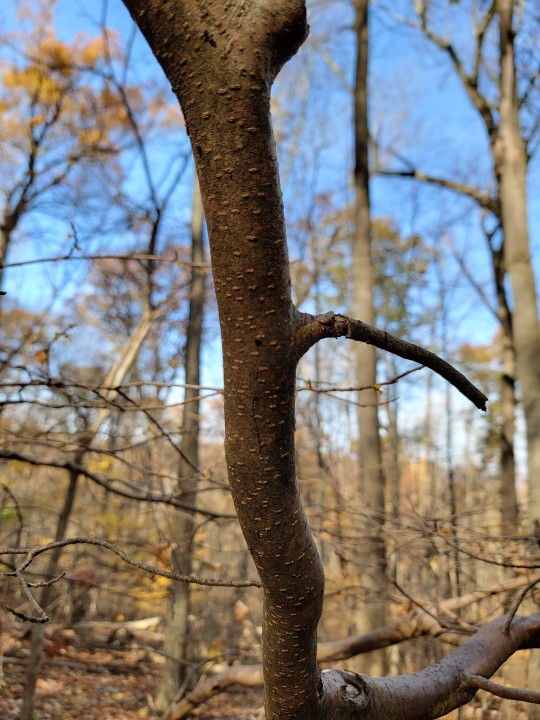
For a quick technical analysis, Witch Hazel has oval alternate leaves that are asymmetrical and have rounded lobes along the sides (image 3 of pressed leaf). The bark is a grey or reddish brown with small lenticels (image 4 of 'trunk') and typically grows in clusters sprouting from deep roots. Typically the plant reaches about 20' in height and 20' in width, as I usually only see specimens this large in very old portions of woodland my assumption is that it takes many decades to achieve this stature.
The flowers themselves are divided into 4 portions with yellow ribbon-like petals present from October-December (image 5, 6, 9). The flowers are extremely fragrant in wet weather and mornings, the scent usually fades in drier conditions. Flowers lose their ribbons and recede into this hardened portion connected to the stem called a calyx (it looks like a rounded pod which can have about 4 seeds in it). The seeds actually shoot out of this pod as a dispersal method around the next fall.
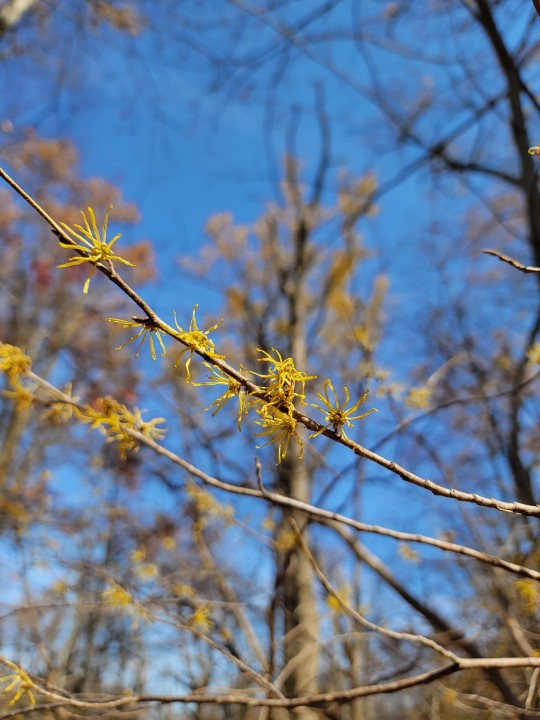
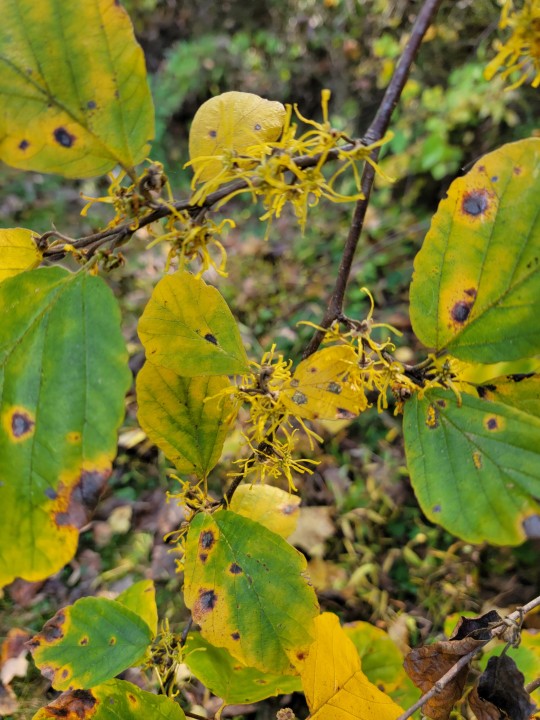
I brought up flowering because like many species in the northeast, there is never a consistent year for these things, while I see witch-hazel flowers every year I don't encounter blooms prolifically unless it's exposed to a lot of sun light. From my experience, a mass-bloom (in which every tree has noticeable blooms like image 1) occurs every 5 years about, I've noticed this in my forest since childhood but others may have more frequent encounters than me.
American Witch Hazel has a large range and is found throughout the Eastern US. The Northern limit of its range is Nova Scotia to Wisconsin staying mostly east of the Mississippi River south until its South Western Limit in East Texas and Northern Florida to the East. Allegedly disjunct populations also exist in Lost Maples Texas and the Eastern Sierra Madres of Mexico but those are fairly isolated from the main range.
There are two other Hamamelis species located within the same range. H. vernalis: Ozark Witch-hazel, which is a common horticultural specimen due to its reddish yellow blooms coming out just before spring and is naturally restricted to the Ozarks. H. ovalis: big leaf witch-hazel is a new species discovered in 2004, found only in one watershed in Mississippi and Alabama; this species has much larger leaves and red mid-winter blooms. Most people are unlikely to encounter these in the wild at all.
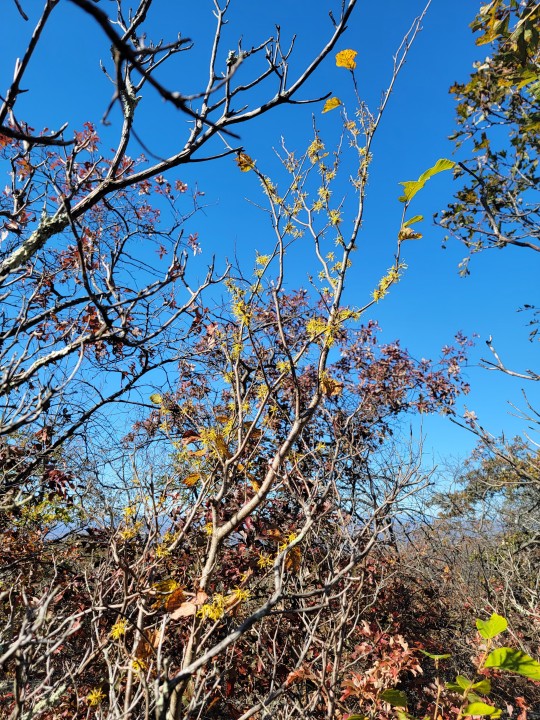
Hamamelis virginiana can grow in both acidic and alkaline conditions, though I tend to find the densest populations on protected north facing slopes in mature forests near where water travels. I've also found it on pure rock on mountain top balds in New York before (image 7 above). This is because in the North, American Witch Hazel isn't as limited in habitat as in the Southern portion of it's range where it's generally restricted to only cove forests and bottom lands. generally there is an association with the Witch Hazel and decent moisture.
Speaking of moisture, Early English settlers (shown by Native Americans) used witch hazel branches as dowsing rod to find underground water sources. Sticking branches in the ground, and watching which portion bent upon encountering streams. It's likely the name 'Witch' in Witch Hazel derives either from Middle English 'Wiche' for 'lively' or Anglo-Saxon 'Wych' for 'bend' describing this use. [Info from US Forest Service].
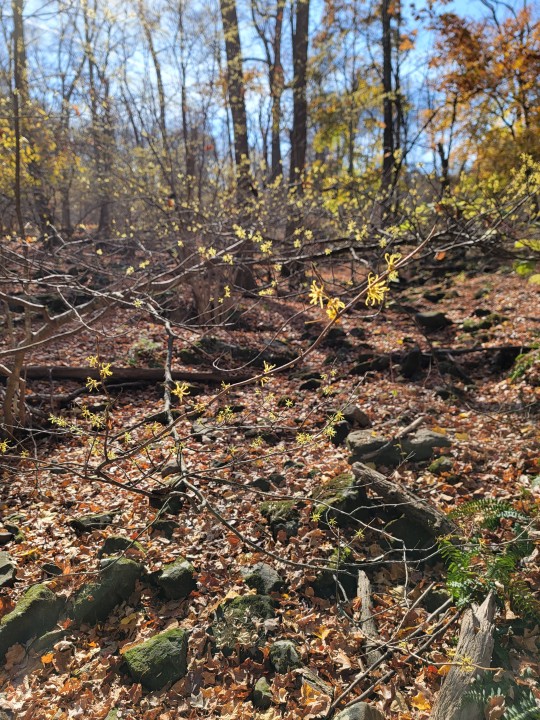
Witch Hazel is also a protector of the forest following disturbance. In a Canadian Journal of Forest Research Study by Taylor Benton, analysis found that where large scale canopy loss was present H. virginiana was found to increase it's basal area growth (think spread) by over 300%. This indicates that in the presence increased light and nitrogen, the dominate understory species are able to protect seedlings by increasing canopy shade!
In my own forest I've noticed this where Ash has died back, the Witch Hazel flowers more prolifically and frequently as well as becoming denser (Image 8 Witch-hazel in flower above a stream)
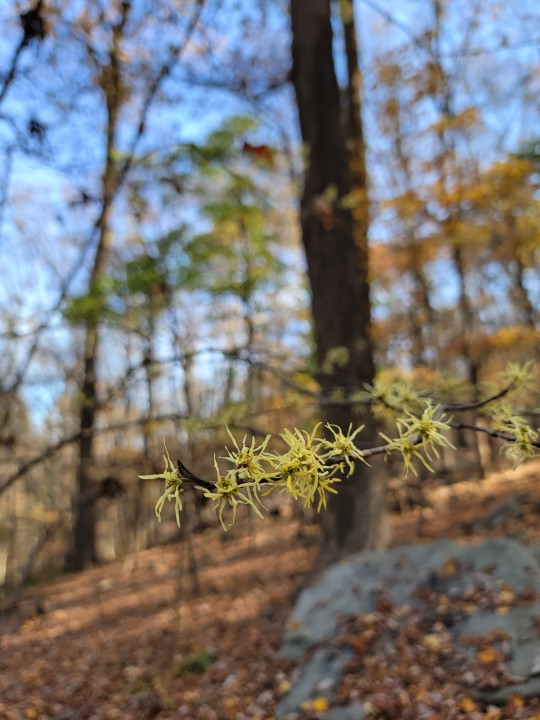
Now what are the ecological relationships associated with American Witch Hazel? This species specifically provides one of the last insect oriented pollen sources prior to winter (other witch-hazel species often bloom in early spring), so species like the owlet moth which are active in winter, and late season bees get a food source from it. The leaves are occasionally predated by a gall wasp which forms many odd tents on the leaf in favorable conditions.
Propagating Witch-hazel for those crazy like me should be aware it is not an easy plant to start. The seeds require a period of moist cold stratification, then warm, then another cold (think 90 days of fridge, 90 days in warmth, 90 days in fridge) then it'll begin to germinate. If you have a full specimen you can attempt layering (which is covering a low branch in soil allowing it to root). You can take softwood cuttings in spring but they have to be kept frost free the next winter.
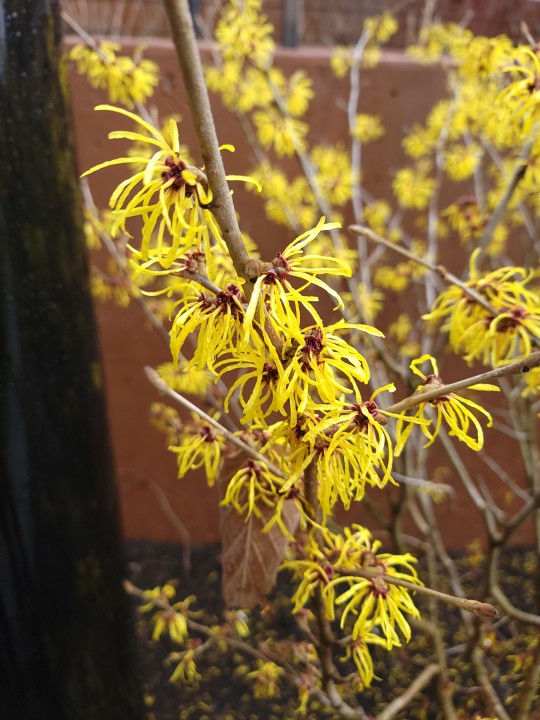
Finally Landscaping advice! Witch-Hazel is best utilized in partially shaded non-south facing or moist areas in partial sun. While it loves total shade in its natural environment it really preforms much better in a garden with some sunlight. American Witch-Hazel also is a better performer in the scent category rather than a showy floral display, most horticultural specimens are derived from hybrids between Chinese, Japanese, or Ozark Witch-hazel (image 10 of possible H. vernalis cultivar above) as their coloring is much more interesting compared to our local powerhouse. However it must be said that American Witch-hazel is resilient and has some flower color variation (oranges and pinks) which are absent in other species.
So this has been my plant profile on American Witch-Hazel, please go into the woods and smell the haunting yellow blooms while the mass-bloom is still occurring. Happy Hunting to my Eastern American followers :)!
#American witch hazel#Hamamelis virginiana#plant profiles#Native Plants of the Eastern United States#Understory Species#Fall and winter flowers
12 notes
·
View notes
Text
Submitted via Google Form:
Hi, I'd like to build a planet with land across the entire planet that is mostly an alpine. I'm thinking that the majority of the land will be tall mountains with almost all shorelines being tall cliffs so even areas close to the ocean can quickly become tall mointains. Places near the equator will have the highest mountains to offset being closer to the sun. How about resources though? What would be abundant, what puld lack? How about other geographical features and conditions that allow a planet to look like this?
Tex: What happens when the tectonic plates meet? Mountains are created via only one type of plate movement (Wikipedia), but due to physics the opposite side of that plate would create the opposite result (Wikipedia). In order to dissipate the forces caused by a plate causing convergent and divergent boundaries, the horizontal movements of a transformation fault would develop (Wikipedia).
Resources can be boiled down to approximately two things: what grows in water, and what grows in soil. For the former, oceans, seas, lakes, and related areas would need to exist and be large enough to develop life of higher trophic levels. For the latter, it would need enough erosion of rocks to create soil, and be propagated by bacteria to facilitate a healthy environment to propagate photosynthetic life and the upper trophic levels that rely on it. (Birds exist, but also birds must roost, so for all intents and purposes they rely on what grows in soil.)
Anything that has above-water places high enough to create what we would subjectively perceive as mountains would have to be an extremely geologically-active planet, where the plates are constantly moving. This would mean things like lots of volcanoes, and likely an atmosphere saturated in gases like sulfur. Extremophiles can grow in these conditions, but because of energy conservation in a geologically-hostile environment, they’re not likely to grow very big.
If you wish for something different, it might be a “dead” planet, in which there’s little geological activity and the state of things like mountain ranges and placement of oceans are effectively locked into place. This would mean an inert core, and possibly a dying planet or else one in a solar system where it’s faced with a dying sun or outside the goldilocks zone of a reasonably active sun.
Addy: So, resources. That's my jam. If you've got a heavily alpine area, you're generally on mountains or mountain slopes, which generally means you're going to be on a whole bunch of rock. That rock could be sedimentary or metamorphic (igneous is also possible, basalt mountains do exist), but it's still rock. Things that rely on heavy amounts of soil - sand, clay, loam, otherwise - will struggle to form into industries.
You might have 3-4 feet of soil ("soil" includes sections that are mostly gravel – if you're looking for dirt, probably only a foot or two). Looking at a couple examples, I'd say you're probably going to get sandy loam, loamy sand, and gravelly loam. Great drainage, not good for food crops. Since you're alpine, that's going to mean you're above the tree line, so timber is going to be scarce as well. Neutral pH to somewhat alkaline, if that matters to ya. Also, above the tree line, the winds get to be very, very harsh - harsh enough that most plants can't survive up there, so crops are doubly not an option.
If you've got a freeze-thaw cycle, then the ground is going to sprout rocks every year in the spring (literally, the freeze-thaw cycle pushes rocks up towards the surface from under the ground, so you get new rocks in your fields every spring as it starts to thaw), so stone for walls and homes will be plentiful. Insulation will likely come from packed earth (e.g. Icelandic turf homes) or animal hides (e.g. yurts). Without good soil for growing, you're going to likely see a lot of animal husbandry - yaks, goats, oxen, and sheep. Maybe small horses, but no large horses; large, Western horse breeds don't do well if they're only grazing - they generally have feed grown for them. Draft horses are large enough that they have to have food grown for them. But ponies are an option.
Your sand will likely be difficult to get separated from the loam/gravel, so glass will be a tricky industry. Clay will be hard to find, so pottery is limited. Also limiting those industries is a lack of easily available fuel - without timber or peat, you've got limited options on what you have available to burn.
If, by alpine, you're also talking about mountain slopes (and maybe valleys?), then you'll have lots of timber. Lots and lots and lots of timber, so long as you don't clear-cut. Berries will be plentiful in the spring and fall, you'll generally have a decent supply of water, you can grow crops if you're careful about your growing seasons (and the ground acts as a refrigerator, so root cellars and similar structures act as a way to preserve food through the winter months), and you've got wild game to supplement.
Animal husbandry is still an option, though you'll almost certainly need to grow feed to keep them fed over the winter. Goats would do better than sheep, I think, but birds (chickens, ducks, partridge, geese) would probably be the easiest animal to raise. With birds, you'll also get down, which will help for quilts and bedding to keep yourself warm at night. Sheep/goats will get you wool, which will be good for clothing to keep warm. If you've got different animals, whatever birds/mammals they've got nearby that can fill the niche.
For fuel, you've got wood and charcoal. Charcoal is made from wood, and it burns hotter and cleaner than wood. Good for large kitchens… or for kilns. Or for metalworking. Or for writing/art. Wood is easier to get, and more suitable to everyday use.
Valleys tend to accumulate clay, gravel, or sand, depending on how fast the water flows. Steep slopes mean fast water, so you'll mostly get gravel. Mild slopes mean slow water, so you'll get a lot of clay (such as many river deltas, where they meet the ocean). Moderate slopes mean medium-speed water, so you'll get sand (or sand with gravel). River sand may not get you high-quality glass, but you can still make basic glass out of it. When the rivers freeze in the winter, you'll have lots of ice. That can be stored underground in ice houses, so that you have ice year-round.
For lime/quicklime, you'll need shells (so beach) or limestone (so depends on mountains type). Lime is used for a variety of things - making mortar for bricks, removing impurities when making iron, making concrete, etc - but you need limestone (or shells, like oyster shells) and fuel to make it. So that really depends on the type of stone the mountains are made of.
Salt may or may not be plentiful, depending on what the mountains are made of. You've got very little ocean access (since cliffs), so drying out seawater for salt isn't going to be effective for large-scale production.
Either way (with or without trees), trade will be difficult. Overland trade will have to deal with snow, ice, and uneven terrain (plus possible food issues for pack animals). Sea-based trade would have to deal with getting goods up or down those massive cliffs without damaging or dropping them.. and also getting people down there, too. Huge altitude changes.
Wootzel: If your main concern is having your planet chilly, you could look at Earth during the last ice age as inspiration. This would probably result in having a planet with a LOT of nigh-unlivable area near the poles, but it could be a way to make most of your land quite cold without having to rely as heavily on high altitudes, if that’s something you want to look into.
18 notes
·
View notes
Text
Chapter 4 Trivia
Tsukasa's stone-cold goals are revealed.
Tsukasa's still got some lion blood on his hand from the punch he delivered in the last chapter.


Because lions have to be stronger than their prey, they're full of muscle and don't have a lot of fat, making their meat tough. Because of the lack of connective tissue and fat to soften the meat through traditional methods, the best way to do it is slowly over a low temperature which prevents the meat overcooking while allowing the connective tissue to break down and soften. Recommendations for cooking lion meat say 57°C over 24 hours. After that, it apparently tastes like pork, but richer.

(I couldn't find any sources on the meat smelling or tasting like ammonia, I'm forced to assume it's a side effect of their territory-marking urine?)
Normally it takes 6-8 weeks to make leather out of skin, but here Tsukasa is wearing it immediately and probably even before the body's become cold, judging by Taiju carrying Yuzuriha's statue to the base in the next panel. This is absolutely disgusting. Don't do this please.


Here we have proof Senku switches out his pouches based on what he needs. What's actually in them is anyone's guess though!

Smoking food works for several reasons. It dries the food (preventing fungal/bacterial growth), the smoke keeps insects away during the process, and the smoke itself imparts preservative and antimicrobial compounds such as the aldehydes Senku mentions. (Too much is toxic though!)

Interesting little habit you have there, Senku...

According to Senku, Tsukasa's skin is extremely pale. I'm not sure if this means he's got Snow White's complexion, or if Senku and Taiju are by comparison very tanned from working outside all day.

Tsukasa may have deemed himself the fighter, but he's no meathead! Based off his thoughtful comments, it looks like Tsukasa is quite scientifically knowledgeable himself, just not as much as Senku.


Adding lime (calcium carbonate) to soil reduces its acidity. Most plants prefer a pH of 6-7.5, which is neutral to slightly acidic. Obviously adding lime to already alkaline soil will make it even more alkaline, so you should test your soil first. Some plants like the acidity!

Heating lime to over 900°C releases CO2 and forms calcium oxide. Adding water and sand to it creates mortar, a substance that hardens by absorbing CO2 from the atmosphere and turning it back into calcium carbonate.
Fun fact: you can use the carbon in mortar for carbon dating!

To make soap, you need a fat (vegetable oil, bacon grease) and a base (lye, wood ash, lime). The goal is to saponify the fat. In modern soaps, calcium carbonate is added to bulk up the product and act as a mild abrasive.

Taiju is a very good friend for Senku because he obviously pays good attention and has a good memory. That is all.
He's just not that great for subtlety or negotiations...

Legally, "disfigurement" means to cause permanent change in a person's body, particularly by leaving visible scars which affect a person's appearance. We don't see any of that on Tsukasa, so did they heal? Was he fighting with broken fingers pre-petrification? What happened?

Freshly broken stone parts are colored in white. Does this mean as long as the stone is still white/unblemished, the pieces can be recombined?

Haha yeah it would be a shame if an evil dictator was woken up...

I still don't understand why Tsukasa skinned the lion where it dropped instead of bringing it back with them if they were going to eat the meat anyway...
31 notes
·
View notes
Text

DETOX SUPPLEMENTS FOR VACCINE INJURED VICTIMS
🖲Magnesium — plays many crucial roles in the body, such as supporting muscle & nerve function and energy production.
🖲NAC — (a precursor to glutathione) provides a variety of protective antioxidant effects, block damages to DNA, strengthening all organs, including the brain — dissolves mucus, improves breathing & respiratory problems. NAC powers up the immune system, boosting antibodies, increasing glutathione, which fights disease & aging. NAC has been around for decades, proven to be very safe, with NO SIDE EFFECTS.
🖲Glutathione — is the body's most powerful antioxidant & counteracts the harmful effects of graphene oxide. Human bodies produce glutathione naturally but over as humans age & absorbs toxins, the production of it slows down. Children naturally have high glutathione levels. Glutathione is a body-specific antioxidant that cells need to function & survive. When you get sick, the level of glutathione can drop.
🖲Selenium — a trace element that is naturally present in many foods & available as a dietary supplement. Selenium, which is nutritionally essential for humans, is a constituent of more than two dozen selenoproteins that play critical roles in reproduction, thyroid hormone metabolism, DNA synthesis & protection from oxidative damage and infection.
🖲Quercetin — have significant capability to interfere with SARS-CoV-2 replication and multi-faceted anti-inflammatory and thrombin-inhibitory actions.
🖲Vitamin D/C/A – promotes immune cell proliferation, stimulates antimicrobial peptides, cytokines and immune cell proliferation, enhances mucosal Integrity, antioxidant, protects healthy cells, activated immune cells, antiviral, coordinates cellular immune response.
🖲Zinc – essential for binding capacity & optimizing lethality of immune cells. Promotes antiviral enzyme blocking viral replication.
🖲Zeolite — has a strong attraction to many heavy metals including mercury, lead, cadmium, and arsenic. It also binds to & removes many chemicals like fluorine & chlorine, eliminating free radicals of all types, and it reverses acute chemical & allergic reactions, all without removing vital nutrients from the body. This makes it a maximum detoxifier.
🖲Pine Needle Tea, Fennel See, Star Anise — contains shikimic acid, high levels of antioxidants & DNA-protective properties.
🖲Dandelion Root — blocks interaction between ACE2, spike protein & variants.
🖲Black Cumin Seed Oil — is natural alternative for Ivermectin. Nigella sativa has been used as traditional medicine for centuries. The oil from its seeds are effective against many diseases like cancer, cardiovascular complications, diabetes, asthma, kidney disease — also effective against cancer in blood system, lung, kidney, liver, prostate, breast, cervix & skin.
🖲Fulvic Acid & Shilajit — have long been used in traditional medicine & reduces inflammation and boost immunity. Fulvic acid has been well studied for its effects on immune health and inflammation. Improve disease resistance, increase your immune defenses, fight inflammation, chronic diseases & enhance antioxidant activity.
🖲Bio-Fibrin — is a proteolytic enzyme (a process known as proteolysis - help dissolve proteins. There are over 700 identified human enzymes, and each enzyme has a specific biochemical reaction involving a specific substance.
Activated Charcoal, Chlorophyll, Chlorella, Spirulina, Irish Sea Moss, C-60, Power Immunity, Infrared Sauna, Green Tea, Alkaline Water, Probiotics, Cinnamon & Raw Honey, Avocado, Garlic, Turmeric, Cilantro, Ginger, Cruciferous vegetables & leafy greens are also great detoxes for the body.
13 notes
·
View notes
Text
Can We Use OSG Kangen Ionized Water to Cook Foods and How Effective This?
Cooking is a primary activity that people perform every day. When used in cooking, OSG kangen ionized water can have several health benefits. So, it is a better cooking companion. This water, because of its alkaline nature, helps to improve the taste and the nutrient content of your food. Let’s have an idea of how you can make your dish healthier and tastier with the use of OSG Kangen water.
Alkaline Water Benefits
Here are the benefits of alkaline water:
Enhance Flavor
Kangen-ionized water enhances the taste of foods. Compared to the strong taste of salt, water from this source is good because it has a neutral or even slightly alkaline taste that enhances the natural flavors of the foods.
It assists in better seasoning absorption which makes the food tastier. Alkaline water helps to counter the effect of acids present in foods making the food have a balanced taste.
Preserve Nutrients
Cooking vegetables in kangen ionized water supports the enhancement of nutrients. If you use tap water to rinse vegetables it will rob them of vitamins. Alkaline water preserves these necessary elements that are necessary to be included in our meals.
Thus it makes the food healthy and balanced. The preparation of foods using OSG Kangen water guarantees nutritionally enhanced digestion and absorption of foods.
Quick and Efficient Cooking
Cooking with this water will reduce the time taken to cook certain foods. This efficiency is healthier and energy-consuming as it conserves more nutrients in foods.
Quicker cooking also implies that you can prepare meals faster but still be able to get the best results. This is especially useful for those who always want to have healthy meals though they do not have much time to prepare them.
Benefits of OSG Kangen Water On Health
Here are some of the benefits that one can expect when they use OSG Kangen Water:
Hydration: Fresh alkaline water hydrates the body better than tap water.
Detoxification: Assists in cleaning the body of toxins.
Digestion: Strengthening of the digestive system and prevention of occurrence of indigestion.
Regular drinking of Kangen Ionized Water has many health benefits to the body. It is useful for the human body and contributes to the improvement of people’s well-being.
Versatile Uses Of Kangen Water in Cooking
You may utilize OSG kangen water in all modes of cooking since it is clean and pure.
Boiling: This water is perfect for boiling pasta, rice, vegetables, or any food you intend to boil. It maintains the structure and taste of food. Because the water is alkaline, the food does not get overcooked and the nutrients of the food are preserved.
Baking: You can prepare many baking recipes using kangen ionized water. It can enhance the structure and taste of cookies, breads, cakes, and many other bakery products. The water helps air incorporated in the dough to expand hence making the end products softer and tastier.
Soups and Stews: Use Kangen Ionized Water in the preparation of soups and stews. It also increases the level of variations of the dishes and the flavors.
Conclusion: Food preparation becomes more enjoyable and delicious when OSG kangen water is used for preparing foods. This implies that the use of the Kangen water can indeed bring a drastic change in your kitchen.OSG Alkaline has domestic Kangen Water systems which are great for household use. This healthy cooking solution named kangen ionized water in addition to enhancing the quality of your cooking will enhance your health. Know the alkaline water benefits and make the transition right now.
#OSG kangen water#kangen ionized water#alkaline water filter price#alkaline water benefits#ionized water benefits#kangen water purifier#alkaline water side effects
1 note
·
View note
Note
re: wooden bathtubs, there's a couple ways you can make wooden vessels watertight & protect the wood itself from the water (two different things!). none are 100% effective & eventually the wood will decay. easiest modern way to deal w/ both problems simultaneously is to encapsulate the wood in petroleum-based plastic of some kind (polyurethane varnish, epoxy resin), which basically removes the wood from the equation altogether except as a structural member (until the plastic fails from UV exposure, wear, stress, etc). you can of course also completely coat the wood in something like tar or paint, which act similarly, but then you lose the natural wood look, so we'll put those options aside.
other options are generally going to involve separating the goals of "protect wood from water" and "seal container", and will rely on the properties of the wood itself. when wood is wet, it absorbs water, which causes the fibers to swell. if a piece of wood is already closely pressed against other pieces of wood on both sides before getting wet, that swelling will make the seam VERY tight - almost perfectly watertight. (of course, this swelling also induces warping & distortion into the wood depending on the pattern of the grain, which needs to be planned for so the pieces of wood don't push each other out of alignment.)
however, most wood doesn't like being wet all the time and will start to rot pretty quickly, so you need to pick a kind of wood that won't do that, at least not on the timescale you're planning. depending on the kind of liquid you're planning on putting into the vessel (salt vs fresh water, different concentrations of alcohol, different acidities/alkalinities, amount of UV exposure, temperature, oxygen exposure), different woods do better or worse. for example, there are oaken foundation piers continually submerged in wet boggy soil in england that are close to a thousand years old. willow i believe is supposed to do well with long-term water exposure (think of the riverbank environments they normally grow in). cedar in particular is naturally permeated with lots of resins & oils that make it very resistant to rot - i would guess that the redder of the wooden baths in that picture is cedar.
also, vessels with continual water exposure usually do better at being watertight than ones that dry out & are refilled - when they dry out, the wood shrinks and the seams literally open up, causing leaks until they rehydrate.
this is so interesting and im in awe and i love you for giving such a detailed answer to my impromptu question
#I LOVE LEARNING NEW STUFF#when ppl share their knowledge with me im immediately in awe#caterjunes#gray answers
2 notes
·
View notes
Text
Not to brag, but I think I recognized the ones shown in that video, and I can teach you a few fun colour-changing reactions to make at home that might get similar results as those. Hit the "read more" for how to make a dramatic transparent-to-blue transformation, vampire paper (bonus: it's the cheapest way to make a stage colour change resulting in bright red), cabbage rainbow (budget way to produce a lot of dramactic colour changes and as a bonus, it will even smell like an actual chemistry lab), styrofoam-eating liquid, magic water that turns and unturns blue on command, and that sweet glowing potion effect with budget options.
(I'm a highschool Chemistry teacher with a flair for the dramactic, but NO school budget for chemicals. Oh, and I know what I'm talking about, so take the safety protocols seriously when I mention them.)
First and easiest experiment:
- A few drops of iodine tincture (usually sold in pharmacies to disinfect wounds)
- Anything with flour or cornstarch in it
Iodine react with starch forming a deep blue complex with has strong colour even at low concentrations. To get something beautiful like the shots above, throw cornstarch in some water and cook it for a few minutes, mixing it al the time, until the solution is crystal clear. This goes in one flask. Then, dilute as much iodine tincture as you want (the more, the darker the blue) in another flask (you can use water or alcohol, depending on the effect you want, I'll explain). Boom, transparent/slightly yellowish liquids that produce a stark blue when mixed.
Bonus: this experiment's name I didn't disclose? Vanishing Ink. Basically, if you dilute the starch as little as possible (put starch in the water while cooking until it doesn't dissolve anymore, then filter that extra powder out) and don't dilute the iodine tincture (or dilute it in alcohol, as high percentage as possible), you will form a mix almost the colour of blue pen ink. BUT, as the tincture evaporates (iodine is a gas at room temperature, and the alcohol evaporates easily), the "ink" loses it's colour. It may take days (or even weeks, depending on lots of factors), but it will vanish. Alternatively, you can draw on paper with the transparent starch solution and brush it with the tincture to "reveal" the invisible writing.
SAFETY WARNING: Since the iodine tincture is usually diluted on alcohol, don't mess with it until after you cooked the starch solution and is not using fire anymore.
Experiment 2: The vampire paper
- Any amount of saffron powder (get at the supermarket or grocery store)
- Ammonia solution (usually sold in cosmetics stores or pharmacies for when you want to bleach your leg/arm hair)
For a "mad scientist" performance, just throw the saffron in one flask with water and mix vigorously and the ammonia solution in a test tube. The ammonia turns the saffron liquid from yelow to bright red. Don't take too long to use the effect, though, because saffron doesn't dissolve well in water and will deposit at the bottom of the flask with time.
You can use other alkaline solutions for the yellow-to-red change, like sodium bicarbonate or sodium hydroxide (caustic soda), but ammonia is what allows for the "vampire paper" effect: dissolve the saffron in as little water as possible and use it to paint a sheet of paper. Let it dry as much as you can. Then, soak the palm of your hand in ammonia and slam it on the saffron paper. It will leave a blood-red wet print on it (some drops might even look like blood spatter if you get it right). But here's the coolest part: as the ammonia evaporates (it goes as fast or even faster than alcohol, if concentrated), the hand print will disappear, as if the paper drew your blood and is now absorbing it.
The more concentrated your ammonia solution is, the quicker it evaporates. That ammonia for bleaching hair is on the weaker side, so it can take a long while, but getting a more concentrated solution for demonstrations in a chemicals shop shouldn't be that hard. For maximum effect, make sure it's a NH3/NH4OH ammonia solution and not an ammonia salt solution (those salts eventually break down into NH3 in water and evaporate, but it takes much longer).
SAFETY WARNINGS: (1) Ammonia has a strong odour and might cause you nausea and headaches. Don't mess with it in spaces without plenty of ventilation. (2) Sodium bicarbonate and caustic soda don't evaporate from the paper (just the water they are in), so don't use them on the vampire paper experiment. Also, and I shouldn't have to say it, don't soak the palms of your hand in caustic soda.
Experiment 3: Rainbow cabbage
- A couple leaves of red/purple cabbage (the stronger the colour, the better)
- A glass of water or so for starting (you might need a little more later)
- An assortment of liquids of different pHs. I suggest floor cleaning products with muriatic/chloridric acid (read the ingredients, brands vary), vinegar or lime juice, sodium bicarbonate solution, ammonia and caustic soda, but you might test whatever you have on hand and choose your favourites
Throw the cabbage leaves and the water on a blender and turn it into a cabbage paste. Plop that paste into a sieve and use a spoon to "milk" the purple water out of it into a glass or bowl. You might add a little water into the paste if you can't extract any liquid. Use as little water as possible because cabbage juice smells rancid when boiled and, if your liquid's colour is too faint, you will have to boil that sucker to reduce it's volume.
Repeat this step until you have as much liquid as you want. I usually blend one cabbage in five-leaves instances to fill a two liter coke bottle, but I don't mind the liquid being a little faint as long as the colours are visible at "back-seats-of-a-classroom" range. If you want darker, richer colours, then you'll need the boil.
Now that you have your purple liquid, you can generate a rainbow worth of colours by mixing it with liquids in different pH ranges. Acid liquids will turn the purple into pink (vinegar, dilluted lime juice) and eventually red (muriatic acid, maybe concentrated lime juice, depending on the variety of lime). Alkaline liquids will turn the purple into light blue (sodium bicarbonate), then green (ammonia), then yellow (caustic soda). The hue is all concentration-dependent, so you might have to mess a bit with different liquids until you get the right colour.
SAFETY WARNING: Cabbage juice is SUPER low shelf life. It'll turn into a stink bomb in just a few days and it will keep releasing a lot of sulfur gas, so it might explode the container you put it into if you forget it sealed for too long (but even if it doesn't explode, just know that when I discarded a month old cabbage juice I had forgotten about, every single neighbour in my apartment building thought I had a burst sewage pipe).
BONUS EXPERIMENT: The substance in red cabbage is very similar to the one in red wine. Meaning that you can soak a rag in an alkaline liquid, like a sodium bicarbonate solution or a very diluted caustic soda solution, and FREAK PEOPLE OUT by spilling wine in it.
Experiment 4: Deflating styrofoam
Styrofoam is made by really small plastic pellets being heated and inflated, like tons of really small sticky air balloons being inflated together and sticking to each other. When it cools down, you have the little pellets bound at any shape you want (but not so bound that you can't pick them appart if you crush the styrofoam thing).
It's INCREDIBLY COOL when you throw a styrofoam piece in the proper solvent, because it kinda disappears almost immediately as you "burst" the little "balloons". On stage, it's pure witchcraft.
To that effect, the solvent you need is acetone, but it's hard to come by concentrated acetone nowadays, for the fastest melting effect. The not-so-impressive-but-still-cool alternative is to add turpentine (a type of paint remover) to nail polisher remover (1 to 1) and mix it for a little while. You then let that mixture rest a bit until it has two layers, like water that you added oil over (if the nail polisher had a dye in it, it might have migrated all to the bottom layer, leaving the upper one all transparent, it's cool to watch). The top layer will have just the acetone and the turpentine, so you can use it to "eat" the styrofoam. Just don't take too long, acetone evaporates quicker than alcohol.
Bonus: all the little plastic pellets of styrofoam will melt into a small mass that feels like chewed bubblegum. You can mold it and let it dry for a few days and you will have a small plastic figurine at the end. It's not a good resin substitute because you will notice that there's VERY little plastic in styrofoam, and the plastic won't have a shiny smooth surface after drying, but it's a fun activity to do with students.
SAFETY WARNING: Turpentine and acetone have a strong smell and can cause nausea and irritation to the touch. Prefearably use gloves when handling them and make sure to do it in a properly ventilated room.
Experiment 5: Magic Blue
It's the hardest one simply because one of the ingredients isn't always easy to come by and you have to follow the measures well, but it is really cool.
- 360 mL water
- 7 g caustic soda
- 12 g glucose (usually found on gym supplement aisles/stores, might be under the name "dextrose" - you might try to use glucose syrup, but it might mess a bit with the effect by adding another colour to the mix, and you will need to add more than 12 grams)
- about 20 drops of methylene blue 1% (usually found in pharmacies as a wound disinfectant)
This amount will be enough for a water bottle worth of the experiment. Scale up or down as needed.
Start by putting the water on a heat resistant container and then adding the caustic soda. Mix it with a spoon (don't use a disposable one).
SAFETY WARNING: Be careful because the water will heat up a lot as the caustic soda dissolves. If your caustic soda is powdered, you might consider adding it little by little. Don't use any container that soften/melts in boiling water, don't hold the container while adding and mixing the caustic soda and make sure that the mixing container won't tip and spill caustic soda water all over you.
When the mix cools down (and only then), add the glucose, mix until dissolved and then drop the methylene blue in. Mix a bit more and the blue should vanish instantly. Put the resulting liquid in a closed container (might be the water bottle I mentioned, or a closed flask for theaters). It's VITAL that the liquid doesn't occupy all of the container. Ideally, you should only fill about half of it.
SAFETY WARNING: clean the exterior very well as to remove all traces of caustic soda and seal the lid firmly, ideally passing at least a loop of duct tape to prevent spilling. If you touch the caustic soda, wash it with lots of running water. The "oily" feeling you will have as you rub the affected fingers together is the soda turning your skin fat into soap, so clean it as soon as possible.
Now that you have your closed bottle/flask, shake it. Like, vigorously shake it not just stirr it a little like a coward.
It should turn blue. But that's not the coolest part. After shaking, let it rest for a few moments and the blue will disappear.
As you might have suspected, adding oxygen to the mix cause a reaction that temporarily lets you see the methylene blue, then it comes back to the state it previously was.
This turning blue moment consumes glucose, so the bottle will stop working after a while (even if left alone, so you have to prepare it fresh when it's time to use it). Just putting more glucose into the mix never really worked for me, so it's best to start all over again. When it was Magic Blue Week on the school lab, I would leave the caustic soda already dissolved in a big jar and the glucose already weighted in little packets, so I just had to add it all in directly into the bottle, seal it and shake it to have it ready for the next class.
SAFETY WARNING: Discard the final liquid (it'll probably be a gross mix of brown and blue) into a toilet while it's flushing. It should dissolve the caustic soda enough to not harm your pipes and the flowing water should keep the methylene blue from reaching and staining your porcelain (it doesn't usually stain, but you won't want to be the unlucky winner of the Smurf Toilet Award).
Experiment 6: Eery glowing potion effect
Last, but not least, if you want that cool glowing effect as you mix the liquids, just add detergent/powdered laundry soap/washing machine soap to the water and turn on a black light lamp pointing directly to the flask. If you don't want a blue glow, just pick the charge rod of a fluorescent marker and let its ink dissolve in a glass of water (or alcohol, depending on the marker). I particularly like those neon yellow, green or orange markers for highlighting text, but the pink one isn't bad. The blue one hardly ever work. For other colours, mix and test markers, in the spirit of a good chemist. X3
SAFETY WARNING: You don't have to dissolve the marker's ink first to test if it will glow well. Shine the black light into its tip and you will see if it glows and how much it glows. If you want to mix colours, you can trace one colour on paper, trace the other above it and then shine the black light on it until you are satisfied.
This counts as a safety warning because, if you aren't the person who buys the markers with your own money, ruining some perfectly good ones for an effect that won't even happen MIGHT result in some damage to your relationship.
If you feel brave enough to intentionally cause some damage in that relationships, though, the neon yellow highlight marker blend almost perfectly with any skin browner than snow white, and it shines BRIGHTLY when you hit it with the black light, even in sunny environments. Make of that what you will. I will NOT take responsibility for any mayhem you might cause with that knowledge.
Happy Halloween, mad scientists!
This is SO COOL
#halloween#chemistry#practical effects#chemical reactions for fun and profit#elevating that mad scientist costume
678 notes
·
View notes
Text
All You Need to Know About INS 500 (ii): A Comprehensive Guide

In the world of food additives, INS 500 (ii) plays a significant role in enhancing the quality and shelf life of various products. While the term might sound technical, this additive is commonly used and has benefits that make it a staple in the food industry.
If you’ve ever been curious about what INS 500 (ii) is, how it’s used, and its potential effects, this guide will provide all the answers in a simple and easy-to-understand manner.
What is INS 500 (ii)?
INS 500 (ii) refers to Sodium Bicarbonate, commonly known as baking soda. It is an alkaline compound that reacts with acidic ingredients to produce carbon dioxide gas, leading to the aeration and leavening of baked goods.
This food additive is widely used not only in baking but also in a variety of other culinary and industrial applications, making it a versatile and indispensable component.
How is INS 500 (ii) Used?
INS 500 (ii) serves several purposes across industries:
Baking and Cooking: It is a key ingredient in recipes that require rising, such as cakes, cookies, and bread. When combined with acidic components like lemon juice, yogurt, or vinegar, it creates a chemical reaction that produces air bubbles, resulting in fluffy textures.
Food Preservation: Sodium bicarbonate helps maintain the pH balance in foods, extending their shelf life.
Cleaning and Deodorizing: Beyond the kitchen, it is often used as a natural cleaner and deodorizer for refrigerators, utensils, and even clothes.
Health and Medicinal Uses: It is commonly used as an antacid to relieve heartburn and indigestion.
Common Foods Containing INS 500 (ii)
INS 500 (ii) can be found in a wide variety of everyday food products:
Baked Goods: Cakes, cookies, muffins, and bread often contain baking soda for leavening.
Beverages: Some fizzy drinks and packaged lemonades use it to enhance fizz.
Processed Foods: Packaged snacks like crackers and chips often include INS 500 (ii) to maintain texture and shelf life.
Desserts: Brownies and other sweet treats rely on it for their soft and chewy textures.
Benefits of INS 500 (ii)
Leavening Agent: Baking soda’s ability to produce carbon dioxide makes it essential for achieving light and airy textures in baked goods.
Preservation: It helps in preventing spoilage by balancing pH levels in food items.
Versatility: Beyond food, its uses in cleaning and medicinal applications make it a multi-functional compound.
Cost-Effective: Sodium bicarbonate is an affordable ingredient that delivers impressive results across various applications.
Potential Side Effects
While INS 500 (ii) is generally recognized as safe when used in recommended quantities, excessive consumption can lead to some side effects:
Digestive Issues: Overuse can cause bloating or stomach discomfort.
High Sodium Levels: People with high blood pressure or those on low-sodium diets should monitor their intake.
Allergic Reactions: Though rare, some individuals may experience sensitivity to baking soda.
It’s important to use this additive in moderation and follow guidelines mentioned in recipes or product labels.
How to Use INS 500 (ii) in Your Kitchen
Incorporating INS 500 (ii) into your cooking is simple and effective:
Baking: Follow recipe measurements carefully to avoid an overpowering taste. Combine with an acidic ingredient to activate its leavening properties.
Cleaning: Mix with water to create a natural cleaning paste for kitchen surfaces and utensils.
Deodorizing: Place an open box of baking soda in your refrigerator to absorb unwanted odors.
Health Remedies: Dissolve a teaspoon in water to relieve indigestion, but consult a doctor for frequent use.
Fun Facts About INS 500 (ii)
Sodium bicarbonate was first discovered in 1791 by a French chemist.
It is an eco-friendly alternative to many chemical cleaners.
Baking soda can also be used in gardening to regulate soil pH.
In ancient times, Egyptians used natural deposits of sodium bicarbonate for cleaning purposes.
Importance of INS 500 (ii) in Everyday Life
From the kitchen to healthcare and cleaning, INS 500 (ii) has established itself as a versatile and indispensable compound. Its ability to perform multiple functions efficiently and cost-effectively makes it a household staple.
Conclusion
INS 500 (ii), or sodium bicarbonate, is much more than a leavening agent for baked goods. Its wide range of uses across culinary, cleaning, and medicinal applications highlights its importance in everyday life.
For a detailed review of INS 500 (ii) and its applications, visit Mishry’s complete guide. Understanding this simple yet powerful compound can help you make the most of its benefits while using it safely and effectively.
0 notes
Text
Alkaline Water: A Comprehensive Guide to Benefits, Side Effects, and Dangers
Alkaline water has gained significant attention in recent years as a potential health-enhancing beverage. This comprehensive guide explores the science behind alkaline water, its purported benefits, potential risks, and what current research tells us about its effects on human health. What Is Alkaline Water? Alkaline water has a higher pH level than regular drinking water. While regular water…
0 notes
Text
What is Kangen Water and How Does it Work?
Kangen Water, a type of alkaline water, has gained popularity in the health and wellness space. Produced using a water ionizer machine, it alters the water’s pH to make it more alkaline. The term "Kangen" means "return to origin" in Japanese, reflecting the idea of restoring water to a more natural, healthy state. The ionization process splits water into alkaline and acidic parts, with the alkaline portion marketed as having health benefits like improved hydration, detoxification, and better pH balance.
The science behind Kangen Water revolves around its ability to increase hydration due to smaller water clusters that are more easily absorbed by cells. Its negative oxidation-reduction potential (ORP) allows it to act as an antioxidant, which may reduce oxidative stress, neutralize free radicals, and support better health. It is also believed to promote better serotonin and melatonin production, potentially enhancing mood, stress levels, and sleep quality.
Kangen Water offers several health benefits, including improved hydration, detoxification, antioxidant effects, pH balance, and enhanced mental well-being. Users have reported higher energy levels, better digestion, healthier skin, and improved sleep. Additionally, Kangen Water can be used in cooking, skincare, and cleaning due to its alkaline and acidic properties.
Despite these benefits, there are some potential drawbacks. The high cost of alkaline water machines, which range from several hundred to thousands of dollars, may deter some buyers. While many people claim to experience health benefits, scientific evidence supporting these claims is limited. Some users may also experience side effects like stomach discomfort or pH imbalances if consumed in excess.
For those seeking a more affordable alternative, the Eavaro Hydrogen Water Bottle provides similar hydration and antioxidant benefits at a lower price. It’s a cost-effective way to enjoy hydrogen-rich water, making it an accessible option for health-conscious individuals. In conclusion, while Kangen Water may offer health advantages, the Eavaro Hydrogen Water Bottle serves as a budget-friendly alternative for those looking to improve hydration and overall well-being.
Read full article here: https://eavaro.com/what-is-kangen-water-and-how-does-it-work/
1 note
·
View note